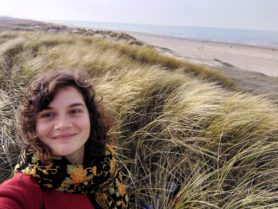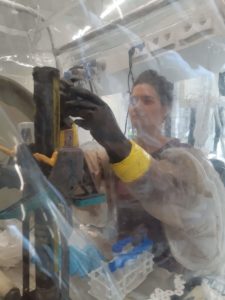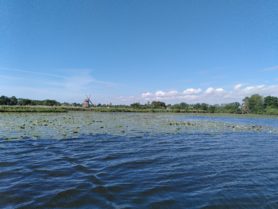Melanie Münch
ESR 11 – Effects of Fe addition on P dynamics and ecology in eutrophic lakes

Utrecht University, Supervisor: Thilo Behrends Contact: m.a.munch@uu.nl |
Nationality: Swiss Education:
Work experience:
Languages: German, English, French, a bit of Dutch and Indonesian |
Hello, good to see you here!
I am Melanie. Originally from Basel, Switzerland, I did my Bachelors in Chemistry in Basel and my Masters in Geochemistry in Utrecht with a short visit to the ETH in Zürich. After working for 5 years in the private sector in Zürich, I decided that I missed doing research too much and was very happy to be given the opportunity to return to Utrecht University to do my PhD in the P-Trap project.
My research focuses on the «Effects of Fe addition on P dynamics and ecology in eutrophic lakes». The decline of surface water quality due to excess phosphorous (P) input is a global problem of increasing urgency. Next to decreasing the phosphate input, finding sustainable measures to restore the surface water quality of eutrophic lakes with respect to P remains a challenge. The addition of iron (Fe) salts has been used to remove dissolved phosphate from the water column of eutrophic lakes in the Netherlands. However the resulting changes of the biogeochemical processes in the sediment as well as the long-term effects of the Fe supplementation on the P dynamics in the sediment and the water column are not well understood yet.

Anoxic slicing of a sediment core from lake Sloene, the Netherlands
I will investigate the coupled P and Fe dynamics in the sediment and its influence on the water column in shallow well mixed Dutch lakes by a combination of fieldwork, lab experiments, and modelling.
In order to constrain the long-term effects of Fe addition, seasonal sampling of sediment and water column of Dutch lakes that have been treated in the past will be used to investigate on the influence on porewater and sediment speciation of Fe, P and other diagenetically relevant elements. P fluxes across the sediment water interface (SWI) will be determined either by in-situ or lab experiments.
Further we aim at carrying out an in-situ lake treatment experiment in close collaboration with the Dutch water authority WaterNet. On the one hand the in-situ experiment would give valuable information about changes in the sediment composition and occurring processes as the state before and after Fe-addition could be compared. On the other hand, so far FeCl3 was used to treat the lakes. We will test Fe containing sludge (Fe(oxy)hydroxides) which is a byproduct of drinking water production for its suitability to be used in lake restoration.
Last but not least a diagenetic model will be developed and validated using the field data. This model will be used to understand key factors and processes and would ultimately be developed into a tool that can be used by authorities to design lake restoration strategies based on Fe addition.

Lake Terra Nova which is part of the Loosdrechtse Plassen lake system. This eutrophic lake was formed due to peat extraction and has been treated with Fe in the past.
For this project I will closely collaborate with Karel, ESR 9 at University of Bayreuth and Victoria, ESR 3 at Deltares in Utrecht. While I will work on shallow, well mixed lake systems, Karel will work on deeper lakes with seasonally anoxic bottom waters. Victoria works on the P dynamics in agricultural drains and we will exchange on methods and observed processes. These collaborations will hopefully enable us to produce complementing data sets that will add to getting a bigger picture.
Further I will have the opportunity to go for secondments at Bayreuth University for general knowledge and skills transfer on investigating lakes, at University of Manchester on identifying microbial communities and their role in the diagenetic processes in the lake sediments, and at the Dutch water authority WaterNet to develop the in-situ experiment but also to review lake monitoring data and developing the model.
I am very happy to be part of the P-Trap community and look forward to a lively exchange and the opportunity to share and learn from each other. I hope to be able to make a relevant contribution to solving the global problem of eutrophication. If you have answers or inputs, I am always interested to reach out, connect and discuss, please don’t hesitate to contact me.
Cheers, Melanie

